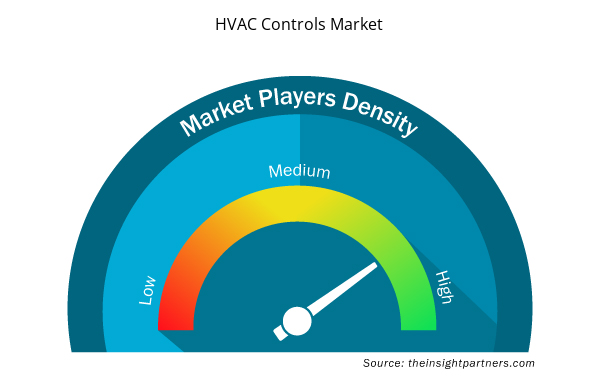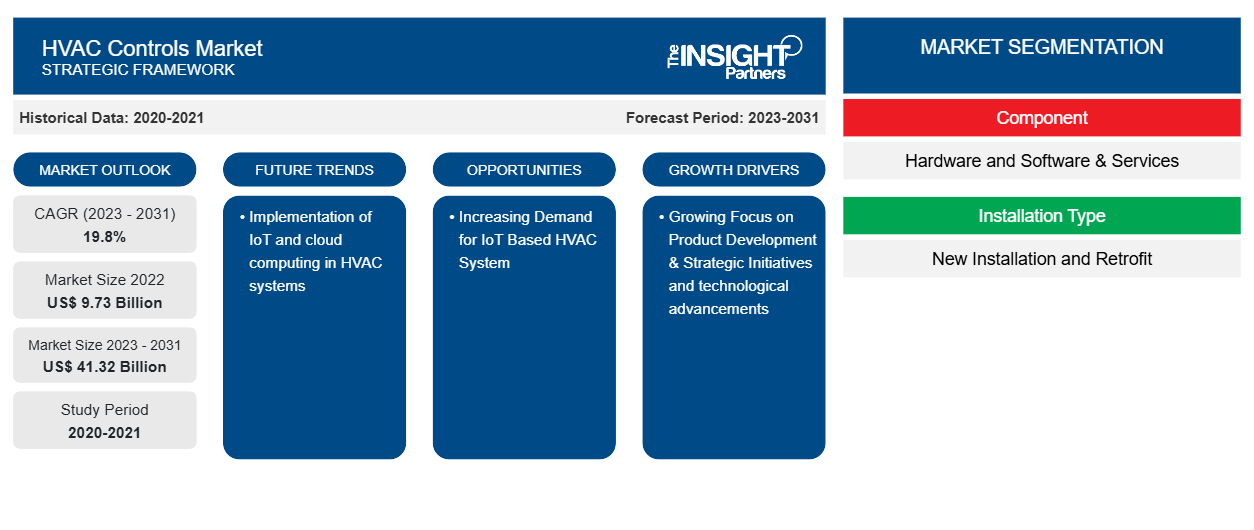HVAC 制御市場は、2022 年の 97.3 億米ドルから 2030 年までに 413.2 億米ドルに成長すると予測されており、2022 年から 2030 年にかけて 19.8% の CAGR で拡大すると予想されています。HVAC システムへの IoT とクラウド コンピューティングの実装は、市場の主要なトレンドになると予想されています。
HVAC 制御市場分析
クラウドベースの HVAC 制御システムは、効率的でインテリジェントなビル管理の未来に急速になりつつあります。インターネットとモノのインターネット (IoT) の力を活用するこれらのテクノロジーは、パフォーマンスの向上、エネルギー使用量の削減、比類のない快適さの新時代をもたらします。クラウドベースのソリューションは、温度、湿度、占有率に関するデータをリアルタイムで取得します。その後、強力なアルゴリズムがこのデータを分析して HVAC のパフォーマンスを向上させます。使用パターンを学習し、需要を予測することで、システムは設定を自動的に変更して、エネルギー消費を削減しながら快適さを提供します。したがって、予測期間中、HVAC システムにおけるクラウド コンピューティングの需要は増加すると予想されます。
HVAC 制御市場業界の概要
HVAC は、暖房、換気、空調の略です。これは、屋内と屋外の両方で空気を移動させることによって空間の温度と湿度を制御するシステムです。HVAC コントローラーは、変化する環境のニーズに対応し、最悪のシナリオにも対応できるように設計されています。HVAC 制御の使用に影響を与える要因には、湿度の変動、建物の占有率、太陽熱負荷、新しい機器などがあります。これらの HVAC 制御はプログラム可能で、カスタマイズされたアプリケーションが可能です。HVAC 制御のアナログ入力は温度、湿度、または圧力を評価し、デジタル入力は高温または低温などの設定に基づいて空気の流れを制御します。
要件に合わせてレポートをカスタマイズする
このレポートの一部、国レベルの分析、Excelデータパックなど、あらゆるレポートを無料でカスタマイズできます。また、スタートアップや大学向けのお得なオファーや割引もご利用いただけます。
- このレポートの主要な市場動向を入手してください。この無料サンプルには、市場動向から見積もりや予測に至るまでのデータ分析が含まれます。
HVAC 制御市場の推進要因と機会
市場の成長を促進するための製品開発と戦略的取り組みへの重点の強化
製品開発と戦略的取り組みへの重点が強化されることで、市場の成長が促進されると予想されます。たとえば、2022年3月、キャリアグローバルコーポレーションの子会社であるAutomated Logicは、既存のOptiFlexデジタルビルディングコントロールラインにVAVコントローラーのモデルOF342とOR141を追加すると発表しました。これらのコントローラーは、空気品質制御とゾーンレベルの温度アプリケーションに効果的です。さらに、2022年5月、ダイキンは空気中のアレルギー検出用センサーを提供する新興企業であるWlab Ltd.への最近の投資を発表しました。この投資は、ACビジネスソリューションにおけるダイキンの成長を加速させるでしょう。
IoTベースのHVACシステムの需要増加
エネルギー効率の高い HVAC システムに対するニーズの高まり、HVAC システムの交換需要の増加、およびインフラストラクチャベースの進歩の加速は、今後の業界の成長を促進する可能性があります。 HVAC メーカーは、消費者にスマート HVAC システムを供給し、市場シェアを拡大するために懸命に取り組んでいます。 商業施設や住宅施設では、照明と HVAC システムが最も多くのエネルギーを消費します。 これらのアプリケーションに IoT を実装し、マシンツーマシン (M2M) 接続を有効にすると、コスト削減、リソースの節約、予測メンテナンス、快適性の制御、および建物のパフォーマンスの向上が期待されます。 したがって、IoT 対応の HVAC 制御システムの需要は、予測期間中に増加すると予想されます。
HVAC 制御市場レポートのセグメンテーション分析
HVAC 制御市場分析の導出に貢献した主要なセグメントは、操作、製品タイプ、基板タイプ、および最終用途による範囲です。
- コンポーネントに基づいて、市場はハードウェアとソフトウェアおよびサービスに分かれています。
- 設置タイプに基づいて、市場は新規設置と改修に分けられます。
- システムに基づいて、市場は温度制御システム、湿度制御システム、換気制御システム、および統合制御システムに分けられます。
- エンドユーザーに基づいて、市場は住宅用、商業用、工業用に分けられます。
HVAC コントロール
地域別市場シェア分析
地域に基づいて、市場は北米、ヨーロッパ、アジア太平洋、中東およびアフリカ、南米および中米に分割されています。
北米の HVAC 制御業界は、相互運用性、接続性、ネットワーク統合、データ分析、システム統合のニーズに牽引されて、大幅な拡大を遂げています。クラウドベースの HVAC システムは、照明やセキュリティなどの他のスマート ビルディング テクノロジーと簡単に接続できます。この統合エコシステムにより、より総合的なビル管理が可能になり、エネルギー効率が向上し、完全にインテリジェントな生活環境や作業環境が生まれます。これらすべての要因により、予測期間中に北米の HVAC 制御市場の成長が促進されると予想されます。
HVAC 制御市場の地域別分析
予測期間を通じて HVAC コントロール市場に影響を与える地域的な傾向と要因は、Insight Partners のアナリストによって徹底的に説明されています。このセクションでは、北米、ヨーロッパ、アジア太平洋、中東およびアフリカ、南米および中米にわたる HVAC コントロール市場のセグメントと地理についても説明します。

- HVAC制御市場の地域別データを入手
HVAC 制御市場レポートの範囲
| レポート属性 | 詳細 |
|---|---|
| 2022年の市場規模 | 97億3千万米ドル |
| 2030年までの市場規模 | 413.2億米ドル |
| 世界のCAGR(2023年~2031年) | 19.8% |
| 履歴データ | 2020-2021 |
| 予測期間 | 2023-2031 |
| 対象セグメント | コンポーネント別
|
| 対象地域と国 | 北米
|
| 市場リーダーと主要企業プロフィール |
|
HVAC コントロール市場のプレーヤーの密度: ビジネス ダイナミクスへの影響を理解する
HVAC コントロール市場は、消費者の嗜好の変化、技術の進歩、製品の利点に対する認識の高まりなどの要因により、エンドユーザーの需要が高まり、急速に成長しています。需要が高まるにつれて、企業は提供を拡大し、消費者のニーズを満たすために革新し、新たなトレンドを活用し、市場の成長をさらに促進しています。
市場プレーヤー密度とは、特定の市場または業界内で活動している企業または会社の分布を指します。これは、特定の市場スペースに、その市場規模または総市場価値に対してどれだけの競合相手 (市場プレーヤー) が存在するかを示します。
HVAC 制御市場で事業を展開している主要企業は次のとおりです。
- キャリア
- ダイキン
- デルタコントロール
- ディステックコントロール株式会社
- エマーソンエレクトリック社
- ハネウェルインターナショナル
免責事項:上記の企業は、特定の順序でランク付けされていません。

- HVACコントロール市場のトップキープレーヤーの概要を入手
HVAC 制御市場のニュースと最近の動向
HVAC コントロール市場は、主要な企業出版物、協会データ、データベースなどの一次調査と二次調査後の定性的および定量的データを収集することによって評価されます。HVAC コントロール市場の動向のいくつかを以下に示します。
- ダイキンクラウドプラスは、商業ビルの HVAC システム制御を次のレベルに引き上げます。ダイキンは、施設管理者、技術者、ビル所有者、エネルギーコンサルタントが、建物のライフサイクル全体にわたって居住者の快適性と環境パフォーマンスのために HVAC システムをリモートで制御および最適化できるようにする強力な新しいツール、ダイキンクラウドプラスを発表しました。(出典: ダイキン、プレスリリース、2024 年 4 月)
HVAC 制御市場レポートの対象範囲と成果物
HVAC コントロール市場の予測は、主要な企業の出版物、協会データ、データベースなど、さまざまな二次および一次調査結果に基づいて推定されています。市場レポート「HVAC コントロール市場の規模と予測 (2020–2030)」では、以下の分野をカバーする市場の詳細な分析を提供しています。
- HVACコントロール市場規模と予測(対象範囲に含まれるすべての主要市場セグメントの世界、地域、国レベル)
- HVAC制御市場の動向、および推進要因、制約、主要な機会などの市場動向
- 詳細なPEST/ポーターの5つの力とSWOT分析
- HVAC コントロール市場分析では、主要な市場動向、世界および地域の枠組み、主要プレーヤー、規制、最近の市場動向を取り上げています。
- 市場集中、ヒートマップ分析、主要プレーヤー、HVAC制御市場の最近の動向を網羅した業界の状況と競争分析
- 詳細な企業プロフィール。
- 過去2年間の分析、基準年、CAGRによる予測(7年間)
- PEST分析とSWOT分析
- 市場規模価値/数量 - 世界、地域、国
- 業界と競争環境
- Excel データセット


- Electronic Shelf Label Market
- Animal Genetics Market
- Human Microbiome Market
- GMP Cytokines Market
- Airport Runway FOD Detection Systems Market
- Lyophilization Services for Biopharmaceuticals Market
- Excimer & Femtosecond Ophthalmic Lasers Market
- Piling Machines Market
- Rugged Phones Market
- Health Economics and Outcome Research (HEOR) Services Market

Report Coverage
Revenue forecast, Company Analysis, Industry landscape, Growth factors, and Trends

Segment Covered
This text is related
to segments covered.

Regional Scope
North America, Europe, Asia Pacific, Middle East & Africa, South & Central America

Country Scope
This text is related
to country scope.
よくある質問
The report can be delivered in PDF/PPT format; we can also share an Excel dataset based on the request.
Carrier, Daikin, Delta Controls, Distech Control Inc., Emerson Electric Co., Honeywell International Inc., Johnson Controls, Lennox International Inc., Siemens, and Schneider Electric are the major market players.
The Global HVAC controls market was estimated to be US$ 9.73 billion in 2022 and is expected, to grow at a CAGR of 19.8% during the forecast period 2022 - 2030.
The global HVAC Controls market was estimated to grow at a CAGR of 19.8% during 2022 - 2030.
Implementation of IoT and cloud computing in HVAC systems are the major trends in the market.
Growing focus on product development, strategic initiatives and technological advancements are the major factors that drive the global HVAC Controls market.
Trends and growth analysis reports related to Electronics and Semiconductor : READ MORE..
The List of Companies - HVAC Controls Market
- Acuity brands inc.
- Lennox international Inc.
- Johnson Controls
- Honeywell
- Siemens
- Schneider Electric
- Emerson
- Carrier
- Daikin
- Delta Controls
The Insight Partners performs research in 4 major stages: Data Collection & Secondary Research, Primary Research, Data Analysis and Data Triangulation & Final Review.
- Data Collection and Secondary Research:
As a market research and consulting firm operating from a decade, we have published and advised several client across the globe. First step for any study will start with an assessment of currently available data and insights from existing reports. Further, historical and current market information is collected from Investor Presentations, Annual Reports, SEC Filings, etc., and other information related to company’s performance and market positioning are gathered from Paid Databases (Factiva, Hoovers, and Reuters) and various other publications available in public domain.
Several associations trade associates, technical forums, institutes, societies and organization are accessed to gain technical as well as market related insights through their publications such as research papers, blogs and press releases related to the studies are referred to get cues about the market. Further, white papers, journals, magazines, and other news articles published in last 3 years are scrutinized and analyzed to understand the current market trends.
- Primary Research:
The primarily interview analysis comprise of data obtained from industry participants interview and answers to survey questions gathered by in-house primary team.
For primary research, interviews are conducted with industry experts/CEOs/Marketing Managers/VPs/Subject Matter Experts from both demand and supply side to get a 360-degree view of the market. The primary team conducts several interviews based on the complexity of the markets to understand the various market trends and dynamics which makes research more credible and precise.
A typical research interview fulfils the following functions:
- Provides first-hand information on the market size, market trends, growth trends, competitive landscape, and outlook
- Validates and strengthens in-house secondary research findings
- Develops the analysis team’s expertise and market understanding
Primary research involves email interactions and telephone interviews for each market, category, segment, and sub-segment across geographies. The participants who typically take part in such a process include, but are not limited to:
- Industry participants: VPs, business development managers, market intelligence managers and national sales managers
- Outside experts: Valuation experts, research analysts and key opinion leaders specializing in the electronics and semiconductor industry.
Below is the breakup of our primary respondents by company, designation, and region:

Once we receive the confirmation from primary research sources or primary respondents, we finalize the base year market estimation and forecast the data as per the macroeconomic and microeconomic factors assessed during data collection.
- Data Analysis:
Once data is validated through both secondary as well as primary respondents, we finalize the market estimations by hypothesis formulation and factor analysis at regional and country level.
- Macro-Economic Factor Analysis:
We analyse macroeconomic indicators such the gross domestic product (GDP), increase in the demand for goods and services across industries, technological advancement, regional economic growth, governmental policies, the influence of COVID-19, PEST analysis, and other aspects. This analysis aids in setting benchmarks for various nations/regions and approximating market splits. Additionally, the general trend of the aforementioned components aid in determining the market's development possibilities.
- Country Level Data:
Various factors that are especially aligned to the country are taken into account to determine the market size for a certain area and country, including the presence of vendors, such as headquarters and offices, the country's GDP, demand patterns, and industry growth. To comprehend the market dynamics for the nation, a number of growth variables, inhibitors, application areas, and current market trends are researched. The aforementioned elements aid in determining the country's overall market's growth potential.
- Company Profile:
The “Table of Contents” is formulated by listing and analyzing more than 25 - 30 companies operating in the market ecosystem across geographies. However, we profile only 10 companies as a standard practice in our syndicate reports. These 10 companies comprise leading, emerging, and regional players. Nonetheless, our analysis is not restricted to the 10 listed companies, we also analyze other companies present in the market to develop a holistic view and understand the prevailing trends. The “Company Profiles” section in the report covers key facts, business description, products & services, financial information, SWOT analysis, and key developments. The financial information presented is extracted from the annual reports and official documents of the publicly listed companies. Upon collecting the information for the sections of respective companies, we verify them via various primary sources and then compile the data in respective company profiles. The company level information helps us in deriving the base number as well as in forecasting the market size.
- Developing Base Number:
Aggregation of sales statistics (2020-2022) and macro-economic factor, and other secondary and primary research insights are utilized to arrive at base number and related market shares for 2022. The data gaps are identified in this step and relevant market data is analyzed, collected from paid primary interviews or databases. On finalizing the base year market size, forecasts are developed on the basis of macro-economic, industry and market growth factors and company level analysis.
- Data Triangulation and Final Review:
The market findings and base year market size calculations are validated from supply as well as demand side. Demand side validations are based on macro-economic factor analysis and benchmarks for respective regions and countries. In case of supply side validations, revenues of major companies are estimated (in case not available) based on industry benchmark, approximate number of employees, product portfolio, and primary interviews revenues are gathered. Further revenue from target product/service segment is assessed to avoid overshooting of market statistics. In case of heavy deviations between supply and demand side values, all thes steps are repeated to achieve synchronization.
We follow an iterative model, wherein we share our research findings with Subject Matter Experts (SME’s) and Key Opinion Leaders (KOLs) until consensus view of the market is not formulated – this model negates any drastic deviation in the opinions of experts. Only validated and universally acceptable research findings are quoted in our reports.
We have important check points that we use to validate our research findings – which we call – data triangulation, where we validate the information, we generate from secondary sources with primary interviews and then we re-validate with our internal data bases and Subject matter experts. This comprehensive model enables us to deliver high quality, reliable data in shortest possible time.


 このレポートの無料サンプルを入手する
このレポートの無料サンプルを入手する